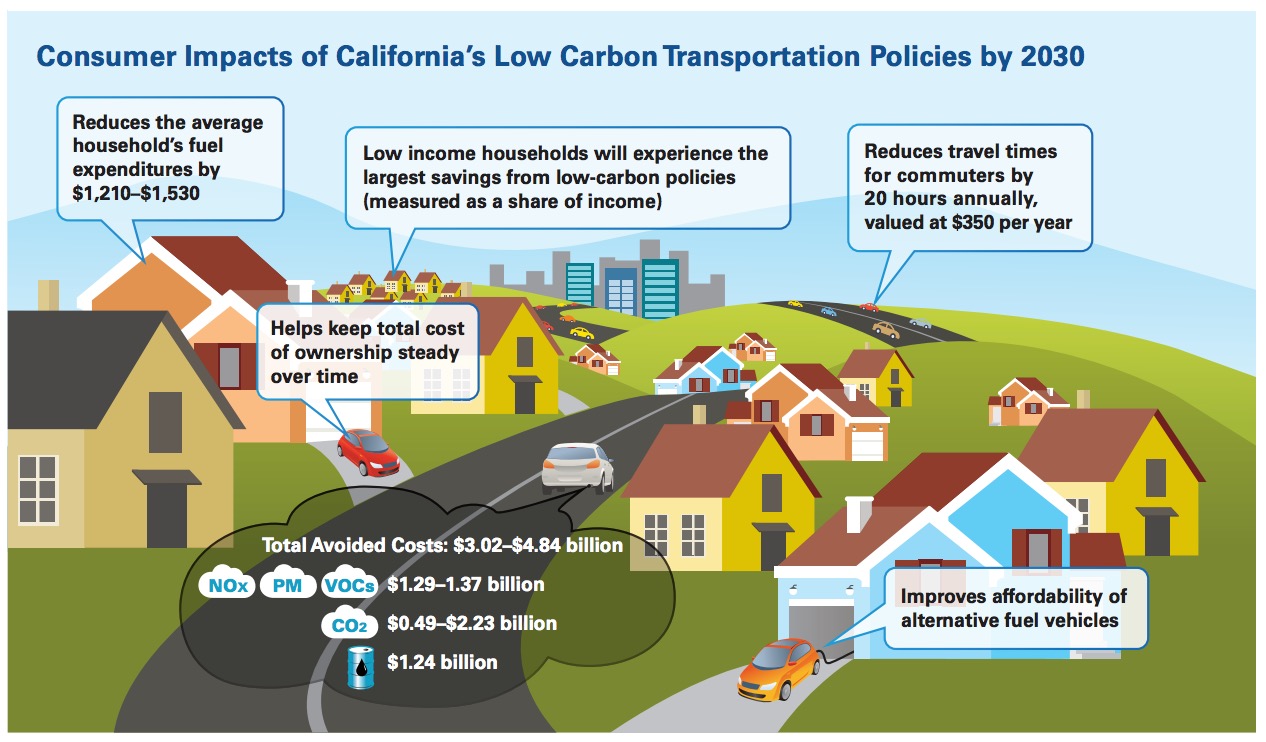CONSUMERS UNION
Executive Summary
California is a global leader in developing and implementing clean transportation policies. The State’s regulatory approach is multifold, using various policy instruments to improve the efficiency of vehicles, reduce the carbon intensity of fuels, and increase options for mobility. These policies are a mix of market-based approaches, direct regulation approaches, and planning opportunities. These policies will have impacts on the pricing of consumer goods such as automobiles and fuels– both of which represent a significant share of consumer expenditures. Focusing exclusively on vehicle and fuel pricing, however, can be misleading. Ultimately, consumer expenditures on travel are a function of vehicle and fuel pricing, as well as parameters such as vehicle efficiency and vehicle miles traveled. Outside of direct consumer impacts, there are also benefits associated with reducing pollutants like carbon dioxide and criteria pollutants.
The objective of this report is to review some of the measurable impacts of California’s transportation policies, focusing on impacts such as fuel expenditures (including a disaggregated review of impacts by income group), vehicle ownership, impacts on travel time and congestion, and avoided damage costs. ICF’s analysis included the compliance associated with California’s Low Carbon Fuel Standard, light-duty greenhouse gas standards (at the tailpipe), the Zero Emission Vehicle Program, sustainable communities strategies (as required by Senate Bill 375, 2008), and the Cap-and-Trade Program (a major element of California’s landmark Global Warming Solutions Act of 2006, Assembly Bill 32). The key results of our findings include:
- ICF estimates that households will save between $1,210–1,530 annually by 2030 (after accounting for the impacts of California’s transportation policies) and that consumers will face considerably lower annual fuel expenditures moving forward. This net savings estimate includes the potential for increased fuel pricing as a result of compliance costs with California’s low carbon transportation policies, as well as the improved efficiency of vehicles and lower vehicles miles traveled that result from these policies.
- ICF finds that the combination of improved vehicle efficiency and reduced vehicle miles traveled from sustainable community planning will reduce lower income groups’ exposure to fuel price shocks. Even though lower income groups buy a larger share of used vehicles, vehicle efficiency improvements will extend into the used vehicle market as well. More specifically, we find that vehicle efficiency improvements (even amongst used vehicles) and a decrease in vehicle miles traveled will reduce the lowest income groups’ exposure to fuel price increases by 40–45 percent by 2030.
- By 2030, ICF finds that the total cost of ownership of alternative fuel vehicles and advanced vehicle technologies will be competitive with, and in several cases, cheaper than conventional vehicles using gasoline.
- Even when reviewing the first cost of ownership for vehicles, whereby only the first year of new vehicle ownership is considered and the lifetime benefits of using cheaper fuels are not fully captured, ICF finds that alternative fuel vehicles and advanced vehicle technologies will be competitive with conventional vehicles using gasoline.
- As a result of California’s sustainable community strategies, ICF estimates that by 2030 Californians will save 350 million hours that they would have otherwise spent sitting in traffic, with a cumulative value of over $6 billion. This translates into an annual savings of roughly 20 hours and $350 per worker. Commuters living and working in greater Los Angeles, California’s largest metropolitan area and one of the most congested regions in the country, will likely receive the largest benefits, as do those in the Sacramento region.
- ICF estimates avoided damage costs, attributable to reduced criteria pollutant emissions, reduced greenhouse gas emissions, and reduced petroleum consumption, in the range of $3.0–4.8 billion annually by 2030 as a result of California’s transportation policies. This monetized value is linked to benefits such as: a) reduced incidences of premature mortality, bronchitis, upper and lower respiratory symptoms, asthma exacerbation, nonfatal heart attacks, hospital admissions, emergency room visits, work loss and restricted activity days, b) avoided costs of climate change, and c) reduced exposure to volatile petroleum markets.
- ICF finds that California’s low carbon transportation policies will yield significant benefits to the state as a whole. For instance, over the next five years, California will spend between $42–$52 billion annually on gasoline fuel expenditures. Without California’s low carbon transportation policies, California would have spent up to $60 billion annually in that same time period.
The graphic and table below summarize the impacts of California’s low carbon transportation policies in 2030.
Download full version (PDF): Consumer Impacts of California’s Low-Carbon Transportation Policies
About Consumers Union
consumersunion.org
“Consumers Union is the policy and action division of Consumer Reports. We work with our million plus activists to pass consumer protection laws in states and in Congress. We hammer corporations that do wrong by their customers, and encourage companies that are heading in the right direction.”
Tags: CA, California, Carbon, Consumer Reports, Consumers Union, Emissions







 RSS Feed
RSS Feed